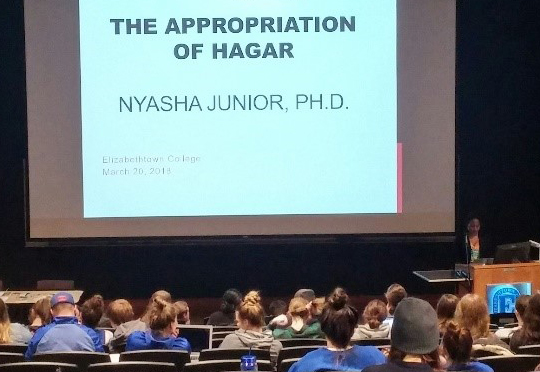 Despite the threat of frigid, inclement weather, snow-covered students and community members shuffled into Elizabethtown College’s Esbenshade Gibble Auditorium on Tuesday, March 20. Their chattering and smiles ignited a warm, welcoming atmosphere within the gathering space. Energy and interest, surrounding the issue of cultural appropriation, was undoubtedly high.
Despite the threat of frigid, inclement weather, snow-covered students and community members shuffled into Elizabethtown College’s Esbenshade Gibble Auditorium on Tuesday, March 20. Their chattering and smiles ignited a warm, welcoming atmosphere within the gathering space. Energy and interest, surrounding the issue of cultural appropriation, was undoubtedly high.
Nyasha Junior, assistant professor in the Department of Religion at Temple University, voiced sincere gratitude and displayed an air of confidence as she took center stage before a full audience. Junior spoke at Elizabethtown College in the hopes of giving further insight into the proposed connection between religion and African American imaginings. Her research-based presentation –“The Appropriation of Hagar” – served as a brief glimpse into the first of her two most recent projects: “Reimaging Hagar: Blackness and the Bible” and “Black Sampson: The Untold Story of an American Icon.”
Junior began her talk by revealing that the inspiration for pursuing this project was driven by her students’ pre-conceived assumptions and reactions towards a Renaissance-era painting observed during a class meeting.
The painting, titled “The Presentation of Hagar,” depicted the Biblical character Sarah offering an enslaved Egyptian named Hagar to her husband Abraham. This scene references a story spanning Genesis 16 and 21: 8-21 contained within the Old Testament of the Bible. As the story goes, Sarah presented Hagar to Abraham as a final effort for him to become a father since she was unable to bear a child of her own.
A majority of her students confessed they had always assumed Hagar to be black due to her documentation as a slave.
Considering the students’ remarks, Junior expressed that she grew all the more curious to understand why Hagar, a character that appeared in various stories throughout the Bible, was overwhelmingly associated with a black identity. She also was interested in learning why ancient European interpreters generally portrayed her as white in their art/paintings.
After pouring over several theological and literary works, Junior said she believes that Hagar was not black, though there are connections that would lead readers to think of her in that way. Instead, she finds that Hagar can be characterized by two separate black traditions, whom she referred to as “Black Hagar” and “Aunt Hagar.” They are fused into one cultural icon.
The first form that Junior discussed, “Black Hagar,” proposed that darkness is not related to skin color, but rather to exotic beauty characterized by the term “mulatta.” Each of the literary pieces she observed were said to make allusions to Hagar as a Biblical figure.
“Aunt Hagar,” by contrast, was deemed not an allusion to the Biblical Hagar, but rather, as a common reference to any woman of color known for taking care of others. The term “Aunt Hagar’s children” thus refers to the African American race as a whole. Each of the literary and musical pieces she observed were said to portray Hagar as a progenitor of the African American race.
According to Junior, people should read the Bible because its importance lies in the ability to “…learn about characters, themes and events that are part of our culture.” She argued that this further “helps to interpret media, music and art…People should know who these people are and where they are in Biblical texts.”
The program concluded with a question pertaining to cultural appropriation as a scholarly issue. Junior left her audience with this: “It is interesting how people are fun and creative with the Bible, but scholars tend to make it boring. There is an importance for scholars to get outside of their comfort zones to appeal to today’s work…Even if not intended, white supremacy appears to be prominent in art and classics. We still have a lot to talk about with how texts are used.”
Rachel Lee, a junior English – Professional Writing major, was among those in the audience who viewed Junior’s talk as an impactful experience. “My biggest takeaway was how much the Bible and its stories have influenced Western culture,” she said. “Before Junior’s lecture, I would not have connected religious studies and cultural misappropriation, but now I see how they can be connected.”
For more on Elizabethtown College’s Religious Studies Department and its related events, please visit http://www.etown.edu/depts/religious-studies/.
Jennifer Simoncelli bio
Jennifer Simoncelli is a member of Elizabethtown College’s class of 2018. She is a senior working toward completing a bachelor’s degree in business administration, a bachelor’s degree in English and a minor in international studies. In fall 2018, she completed a senior thesis paper for her international studies minor using elements from her secondary concentration in professional writing. Simoncelli currently participates in an independent study with David C. Downing, Ralph W. Schlosser Professor of English and director of the Professional Writing program, which contains elements complementing both marketing and professional writing concentrations. It is by receiving this individualized attention that she is learning how to perfect her skills in publishing and public relations writing. After graduating in May, Simoncelli plans to pursue a career within the advertising/public relations sector.

